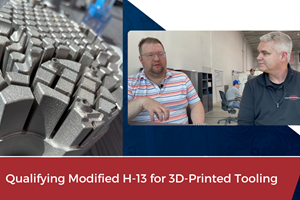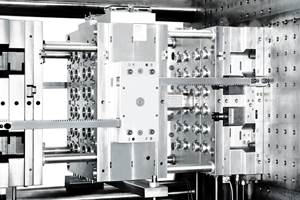Bridging the Gap between Prototyping and Final Steel Production Tooling
SL modeling and rapid tooling methods combine to produce durable epoxy injection molds that generate production-quality parts in record time.
The benefits of additive technologies for rapid modeling and prototyping of new part designs to reduce time-to-market are well known. Equally important to minimizing product introduction leadtimes is the ability to quickly build end parts. Today a record number of processes and materials are available for rapid manufacturing: new-generation, high-durability stereolithography (SL) photopolymers; additive fabrication methods such as 3-D printing; super-strong, aluminum-filled epoxy tooling systems; and the widespread availability of multi-axis, CNC milling equipment.
Advanced Prototype Molding (Palantine, IL) has found that for the rapid production of parts ranging from automotive components and consumer electronics to appliance and business equipment housings, it can meet customer needs most cost effectively by using SL patterns and cast epoxy tooling. Together these additive processes, supported by the use of CNC-machined metal inserts and mold bases as needed, offer reliable, high-quality results to bridge the gap between prototyping and final, steel production tooling for molding from 10 to several hundred thermoplastic parts. Moreover, based on the experience Advanced Prototype Molding toolmakers and its materials suppliers have gained in recent years, there is today an unprecedented ability to quickly mold highly complex designs with a variety of surface finishes from plastics ranging from ABS and polycarbonate to glass-filled nylon.
Project Evaluation
According to Bruce Megleo, president of Advanced Prototype Molding, “Design engineers frequently make the decision to use hard tooling without considering the options available with today’s advanced SL resins and aluminum-filled epoxies. While the use of hard tooling continues to be appropriate for high-volume, 100,000+ part molding projects and for parts being built from abrasive or super-high-temperature plastics, our customers opt for RenCast® epoxy tools nearly every time when part volumes are low and rapid delivery is critical.”
One Advanced Prototype Molding client called to request an aluminum tool for injection molding about 100 parts for a complex, two-piece electrical enclosure. Megleo reports that delivery would have taken eight to 10 weeks; cost would have been about $42,000. The manufacturer was quick to switch to use of Huntsman Advanced Materials’ RenCast® 2000 epoxy for cast injection molds when Megleo offered to deliver production-quality, injection-molded PC parts in just two weeks for a total cost of $18,000.
Another Advanced Prototype Molding customer asked Megleo to compare costs for aluminum versus epoxy tooling for a small molding project. Pricing on the molds was virtually the same. Machined aluminum injection molds would have cost $8,000 while cast epoxy molds would be $7,500. The deciding factor was time. Delivery on machined aluminum tools was four to five weeks while the cast epoxy molds could be ready to produce parts in two weeks. Design engineers on the project selected the epoxy option.
SL Patternmaking
Supporting the ability of moldmakers to produce high-quality, rapid tooling is the availability of digital design data for the large majority of new part designs. Advanced Prototype Molding customers typically supply their part designs electronically. Toolmakers then manipulate data to determine mold parting lines and forward the information to the service bureau that builds their patterns. For many of Megleo’s projects, RenShape® SL 7545 photopolymer is used. The Huntsman SL resin combines good flexural and tensile strengths with high elongation to generate durable models that can withstand the epoxy moldmaking process.
Megleo explains, “We support SL models to ensure their ability to maintain dimensional accuracy when exposed to the heat and weight generated by the epoxy casting system.” The ability to readily remove an SL pattern from the cast mold is important as well. Advanced Prototype Molding has found that the models produced via 3-D printing are typically difficult to demold. By contrast, SL patterns can be buffed to a glossy surface that facilitates removal from cast tooling. SL model surfaces can also be textured to produce epoxy injection molds that yield thermoplastic parts with production-quality surface finishes.
Epoxy Tooling
Just as the SL materials used for patterns today are easier to work with and exhibit improved durability than first generation photopolymers, RenCast® 2000 epoxy is better suited to reproducing fine part details than traditional epoxies even though the material is heavily filled with aluminum.
Megleo reports, “The Huntsman casting system provides us with numerous options in building tools. For example, the epoxy accommodates incorporation of cooling lines when needed to control mold temperature. The RenCast® 2000 epoxy also provides for easy addition of machined aluminum inserts in mold areas that are particularly intricate or will be exposed to excessive wear during molding.” Advanced Prototype Molding builds free-standing injection molds up to one-inch thick in a single pour. For added support, the RenCast® 2000 epoxy is cast into an aluminum mold base. When thick mold walls are required for large parts, chunks of cured epoxy are added as economical fillers during casting.
Megleo adds, “For injection molds, RenCast® 2000 epoxy offers significantly improved durability over traditional epoxy laminate tooling that had a tendency for surfaces to chip after producing only 25 parts.” The aluminum-filled system can withstand exposure to temperatures as high as 500ºF using a 3-1/2 to 4-minute cycle time and air-cooling tool surfaces every third shot. Typical injection gauge pressures range from 600 to 1,500 psi.
Summary
He concludes, “Five years ago, engineers were happy to get parts in six weeks. Now, customers tolerate two-week leadtimes, but would prefer to have parts as quickly as four or five days. The SL resins and RenCast® 2000 epoxy system we use is helping us minimize delivery times on every project without sacrificing end-part appearance, accuracy or overall quality.”
RenCast and RenShape are registered trademarks of Huntsman Corporation or an affiliate thereof in one or more, but not all, countries.
Related Content
Coating Technology Enables Tough Mold and Die Steel Machining
Millstar, a part of Cole Tooling Systems, presents a multi-layer hybrid nanocoating for cutting tools that provide key benefits for increased efficiency in any machining operation.
Read MoreVIDEO: Qualifying Modified H-13 for 3D-Printed Tooling
Next Chapter Manufacturing and International Mold Steel discuss their partnership to qualify a modified H-13 for tooling applications.
Read MoreHow to Lower Cycle Times With the Right Tool Steel
Combining excellent mechanical properties, high wear resistance and high thermal conductivity in a specialty tool steel yields cycle time reduction.
Read MoreReliable, Efficient 3D Printer for High-Quality Tool Steel Components
The updated TruPrint 2000 underscores Trumpf’s focus on the tool and die industry, including a larger, square build plate and various features to ensure high quality and mass production.
Read MoreRead Next
Are You a Moldmaker Considering 3D Printing? Consider the 3D Printing Workshop at NPE2024
Presentations will cover 3D printing for mold tooling, material innovation, product development, bridge production and full-scale, high-volume additive manufacturing.
Read MoreHow to Use Continuing Education to Remain Competitive in Moldmaking
Continued training helps moldmakers make tooling decisions and properly use the latest cutting tool to efficiently machine high-quality molds.
Read MoreReasons to Use Fiber Lasers for Mold Cleaning
Fiber lasers offer a simplicity, speed, control and portability, minimizing mold cleaning risks.
Read More



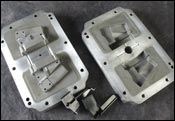
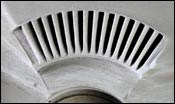
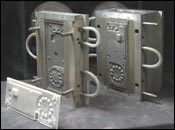
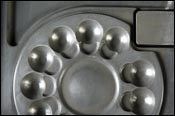
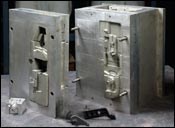









.jpg;maxWidth=300;quality=90)






